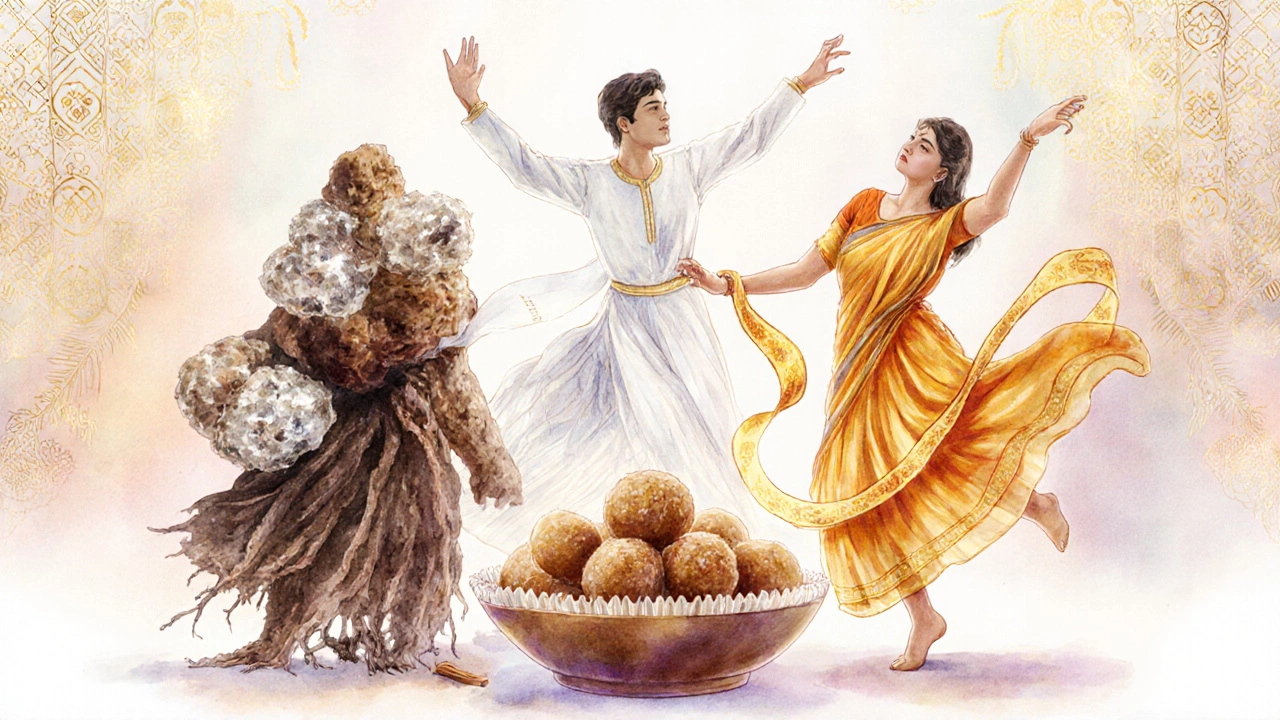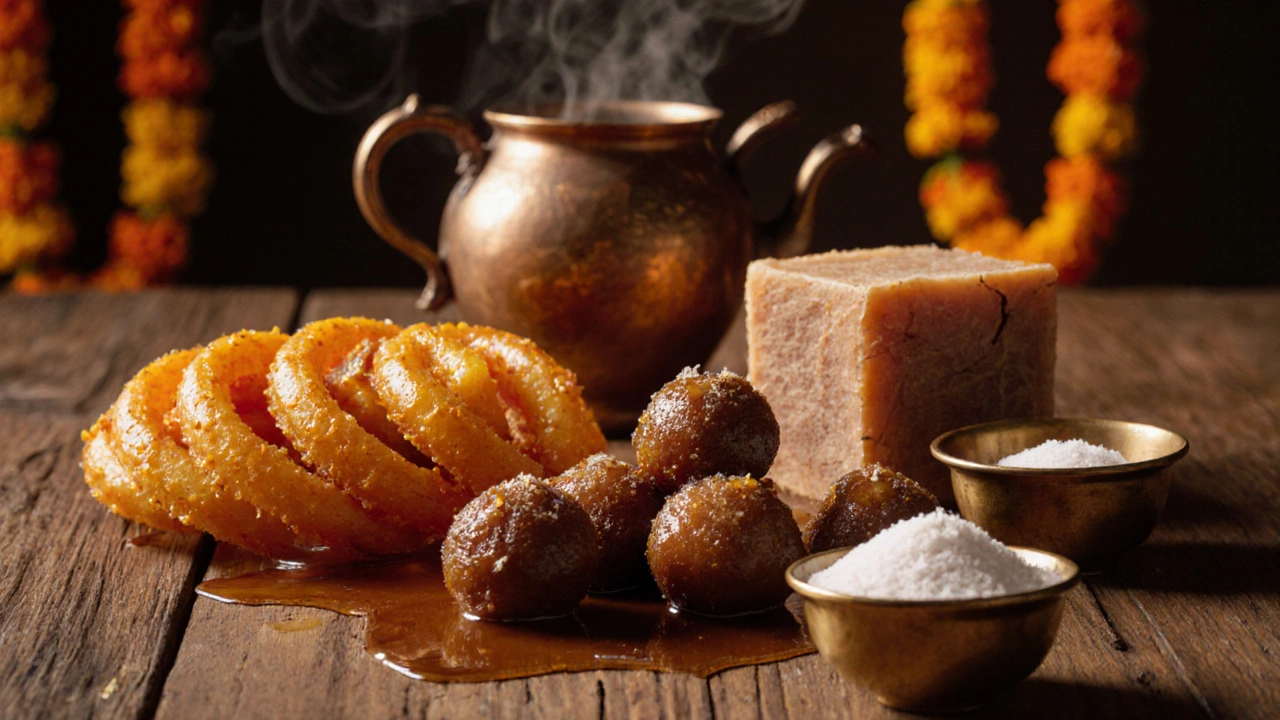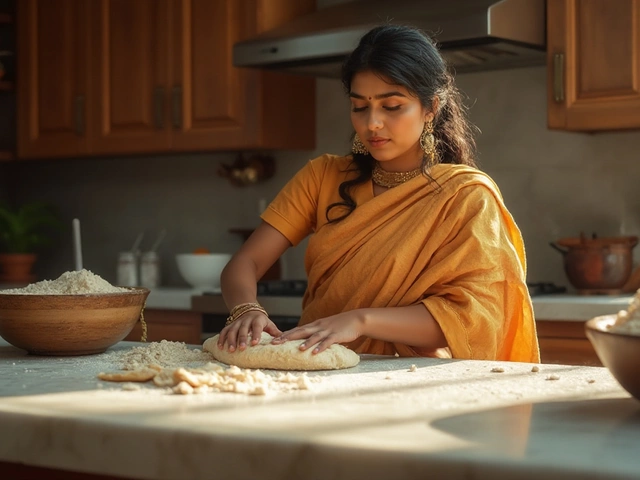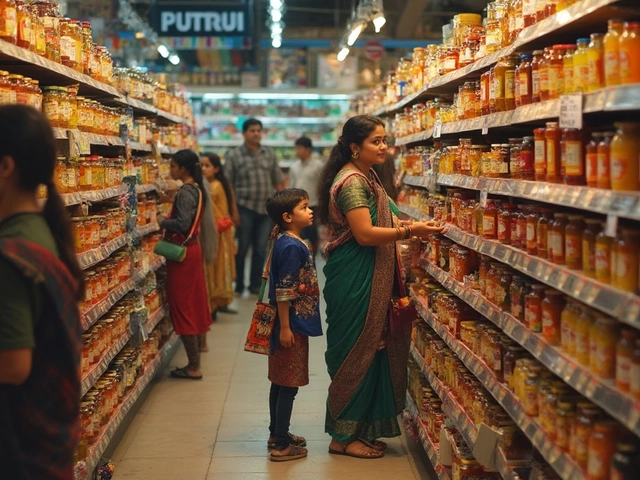Ever bite into a warm, sticky piece of jalebi and wonder why it tastes so different from the sugar cookies you grew up with? It’s not just the spices or the oil-it’s the sugar. Indian sweets don’t use plain white granulated sugar like Western desserts. They rely on a handful of traditional sweeteners, each bringing its own flavor, color, and texture. If you’ve ever tried making Indian sweets at home and ended up with something too hard, too grainy, or just flat-tasting, the problem might not be your technique-it’s the sugar you chose.
What Sugar Do Indian Sweets Actually Use?
Indian sweets use three main types of sweeteners: jaggery, white sugar, and sugar syrup. But it’s not as simple as picking one. Each sweet has a preferred type, and using the wrong one can ruin the texture or flavor. For example, gulab jamun needs a light sugar syrup to soak into the dough without making it soggy. But gur ke chakki, a rustic sweet from Uttar Pradesh, only works with unrefined jaggery-it’s what gives it that deep, molasses-like earthiness.
Jaggery, or gur, is the most traditional. Made by boiling sugarcane juice until it thickens and solidifies, it’s used in almost every region. In Maharashtra, modak-the sweet dumplings offered to Lord Ganesha-are filled with jaggery and coconut. In Bengal, rasgulla is sometimes made with a jaggery-based syrup for a richer taste. Even today, in rural households across North India, jaggery is the default sweetener for festivals like Diwali and Pongal.
Jaggery: The Heart of Traditional Sweets
Jaggery isn’t just sugar with color. It contains trace minerals like iron, magnesium, and potassium-something refined white sugar doesn’t. That’s why it’s often called “unrefined cane sugar.” But its real value in sweets is flavor. When melted, jaggery gives a caramelized, almost smoky depth that white sugar can’t replicate. It’s the reason chikki (a peanut brittle) from Gujarat has that complex, lingering aftertaste.
Not all jaggery is the same. In South India, it’s often made from palm sap and called karupatti. It’s darker, stronger, and used in temple offerings and medicinal sweets. In North India, sugarcane jaggery is more common and lighter in color. The texture varies too-some is soft and chewy, others hard like a rock. For sweets, you want the soft, block form that melts easily. If you’re buying it, look for a deep amber color and a slightly sticky surface. Avoid anything that looks crystallized or too dry-it’s been stored too long.
White Sugar: The Modern Favorite
White granulated sugar became popular in Indian sweets during the 20th century, especially in urban areas. It’s cleaner, cheaper, and easier to control. You’ll find it in most commercial barfi, kheer, and halwa sold in shops. It’s the go-to for sweets that need a pure, neutral sweetness without any earthy notes.
But here’s the catch: white sugar behaves differently when heated. It crystallizes faster than jaggery. That’s why mysore pak, a rich ghee-based sweet from Karnataka, uses a mix of white sugar and ghee cooked to the perfect thread stage. Too much heat, and it turns brittle. Too little, and it stays sticky. The sugar has to dissolve completely and then be stirred just enough to avoid graininess.
Many home cooks now use powdered sugar for sweets like shrikhand or peda because it dissolves instantly. But purists say it lacks body. That’s why you’ll still see traditional sweetmakers in Jaipur or Varanasi using coarse white sugar-grind it yourself if you can.

Sugar Syrup: The Soaking Agent
Many Indian sweets aren’t sweetened by mixing sugar into the batter-they’re soaked in syrup after cooking. Rasgulla, rasamalai, jalebi, and gulab jamun all rely on this technique. The syrup is usually made from white sugar and water, boiled to a one-string consistency. That means when you drop a bit into cold water, it forms a soft thread between your fingers.
The syrup isn’t just sugar water. It often has cardamom pods, saffron strands, or rose water added. In some parts of South India, they even add a pinch of lemon juice to prevent crystallization. The syrup needs to be warm when you add the sweets-cold syrup makes them hard and rubbery. And the soaking time matters: 15 minutes for rasgulla, 2 hours for gulab jamun. Too short, and they’re bland. Too long, and they fall apart.
Why Not Honey or Maple Syrup?
You might wonder: why not use honey, coconut sugar, or maple syrup? They’re trendy now. But they don’t work. Honey has too much moisture and a strong floral taste that clashes with ghee and cardamom. Coconut sugar burns easily and turns bitter at high heat. Maple syrup? It’s too watery and has a flavor profile that doesn’t blend with Indian spices.
Indian sweets are built around a specific chemistry: high heat, slow simmering, and sugar that caramelizes just right. The traditional sweeteners have been tested over centuries. Honey might be healthier, but it won’t give you that glossy, sticky laddoo that melts in your mouth.

What to Buy and How to Use It
If you want to make authentic Indian sweets, here’s what you need:
- Jaggery: For rustic sweets like chikki, modak, or gur ke chakki. Buy in blocks, not powder. Grind it yourself if needed.
- White granulated sugar: For barfi, kheer, halwa, and syrup. Use coarse or fine, depending on the recipe. Avoid icing sugar unless specified.
- Sugar syrup: Always make your own. Boil 1 part sugar to 1 part water until it reaches one-string consistency. Add flavorings at the end.
Don’t substitute. If a recipe says jaggery, don’t swap it for brown sugar. Brown sugar has molasses, but it’s processed and lacks the mineral depth. It’ll change the texture and flavor in ways you won’t expect.
Common Mistakes and How to Fix Them
Here’s what goes wrong-and how to fix it:
- Grainy barfi: Sugar didn’t dissolve fully. Always stir gently over low heat until the sugar melts completely before boiling.
- Soggy gulab jamun: Syrup was too hot when added. Let it cool to lukewarm before soaking.
- Jalebi too hard: Syrup was boiled too long. Stop at one-string stage.
- Jaggery won’t melt: It’s old or too dry. Break it into small pieces and add a splash of water before heating.
Test your syrup with the finger method. It’s old-school, but it works every time. And don’t rush the process. Indian sweets aren’t made in 10 minutes. They’re made with patience-and the right sugar.
Is jaggery better than white sugar for Indian sweets?
It depends on the sweet. Jaggery adds depth and is traditional, but white sugar gives a cleaner, brighter sweetness. For festive sweets like barfi or halwa, white sugar is preferred. For rustic, regional sweets like chikki or modak, jaggery is essential. Neither is “better”-they serve different purposes.
Can I use brown sugar instead of jaggery?
No. Brown sugar is refined white sugar with added molasses. It lacks the mineral richness and complex flavor of real jaggery. It’ll make your sweets taste artificial and may change the texture, making them too moist or sticky.
Why do my rasgullas turn rubbery?
You likely boiled the syrup too long or added the dumplings to cold syrup. The syrup must be at one-string consistency and lukewarm when you add the rasgullas. Boiling it too hard makes the syrup too thick, which hardens the outer layer. Always simmer gently and test with your fingers.
Where can I buy real jaggery outside India?
Look in South Asian grocery stores, especially those that carry Indian or Sri Lankan products. Brands like “Aashirvaad Jaggery” or “Mysore Jaggery” are widely available online. Avoid products labeled “cane sugar” or “brown sugar”-they’re not the same. Check the ingredient list: it should say only “sugarcane juice.”
Do Indian sweets use artificial sweeteners?
Rarely, and never in traditional recipes. Artificial sweeteners don’t caramelize, don’t create syrup texture, and lack the mouthfeel that makes Indian sweets satisfying. You might find them in diabetic-friendly versions sold in pharmacies, but they’re not considered real sweets by most families.
Next Steps: Try This Simple Recipe
Start with gur ke laddoo-a no-fail sweet that shows the power of jaggery. You need:
- 1 cup jaggery, grated or finely chopped
- 1 cup besan (chickpea flour)
- 2 tablespoons ghee
- 1/4 teaspoon cardamom powder
Heat the ghee in a pan. Add the besan and roast on low heat for 8-10 minutes until it smells nutty and turns golden. Add the jaggery and stir until it melts completely. Turn off the heat, add cardamom, and mix well. Let it cool slightly, then roll into balls. They’ll be soft at first, then firm up as they cool. No sugar syrup needed. Just pure, earthy sweetness.
This is what Indian sweets are made of-not just sugar, but tradition, texture, and time.











